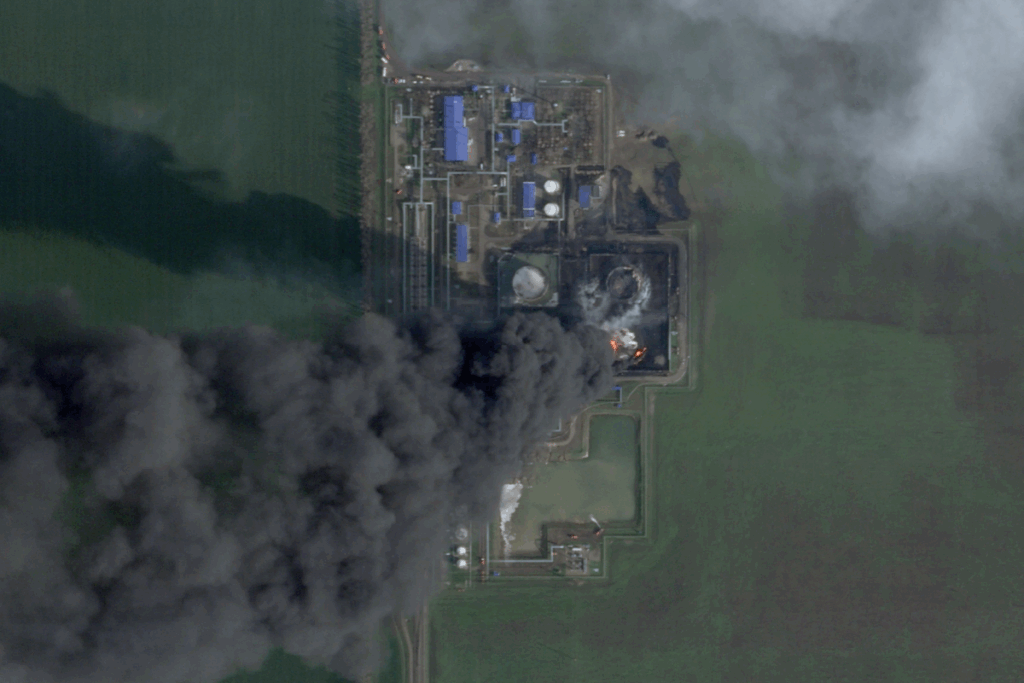Massive Strikes Cripple Gas Infrastructure
Ukraine’s energy network suffered severe damage after Russia launched one of its largest assaults of the year, hitting gas facilities across multiple regions. The attack coincided with President Volodymyr Zelenskyy’s trip to Washington for high-level talks with U.S. President Donald Trump about supplying long-range Tomahawk cruise missiles to Kyiv.
According to Ukrainian officials, more than 300 drones and 37 missiles — many of them ballistic — were fired overnight, striking facilities in Chernihiv, Kharkiv, Poltava, Sumy, and Vinnytsia. The Shebelinka gas processing plant in the Kharkiv region was among the hardest hit, with staff reporting simultaneous fires triggered by drones and missiles. Black smoke was seen rising for hours after the explosions.
Naftogaz CEO Sergii Koretskyi confirmed widespread destruction. “There are hits and destruction in several regions at once. The operation of a number of critically important facilities has been halted,” he said. Ukraine’s state grid operator, Ukrenergo, responded with emergency power cuts across the country as engineers worked to restore the damaged network.
Escalating Pressure on Ukraine’s Energy Sector
The latest assault follows Russia’s recurring winter strategy of targeting Ukraine’s power grid. Since the start of the invasion in 2022, Moscow has repeatedly attacked energy facilities in an effort to undermine the country’s economy and morale. Early estimates suggest up to 60% of Ukraine’s gas production has been disrupted by recent strikes.
Ukraine’s air force said its defenses intercepted 283 drones and five missiles, but critical infrastructure in Kharkiv and Poltava was still heavily affected. Private energy firm DTEK confirmed one of its gas production sites was forced to shut down. The strikes caused blackouts in eight regions and left hundreds of thousands of residents without electricity or heat.
Russia’s defense ministry claimed the attacks were retaliation for Ukrainian strikes on Russian refineries, stating it used Kinzhal hypersonic missiles to target “military-related facilities.” Ukrainian officials dismissed this claim, calling it another deliberate attempt to cripple civilian infrastructure.
New Concerns Over Foreign Troops
Adding to the escalating tensions, Ukraine reported that North Korean soldiers stationed in Russia have been operating drones along the border for reconnaissance missions — the first acknowledgment of North Korean involvement in months. Last year, thousands of North Korean troops fought alongside Russian forces in the Kursk region before being withdrawn after heavy losses.
Ukraine’s intelligence services now believe Pyongyang may again be providing limited support through drone surveillance, raising concerns about deeper military cooperation between Moscow and North Korea.
Washington Talks and the Tomahawk Question
As the bombardment unfolded, Zelenskyy traveled to Washington to discuss advanced weapon supplies with Trump. The Ukrainian leader’s visit follows two recent calls between the presidents, marking a notable shift in relations. After a tense exchange earlier this year, Trump has grown more outspoken against Vladimir Putin and more receptive to aiding Kyiv.
Senior Ukrainian officials met with representatives from U.S. defense firms, including Raytheon, which manufactures Tomahawk cruise missiles. Sources familiar with the discussions said the potential shipment could significantly alter the battlefield dynamic by extending Ukraine’s strike range deep into Russian territory. “They need a political signal,” one official said, noting that the decision now rests with the White House.
Moscow, meanwhile, warned that providing Tomahawk missiles to Ukraine would “rupture” diplomatic ties with Washington and escalate the conflict. While U.S. officials have not disclosed the number of missiles under consideration, sources suggest the proposed arsenal would be “enough for Putin to feel it.”
As the energy crisis deepens and the political stakes rise, the outcome of Zelenskyy’s talks in Washington could mark a pivotal moment for Ukraine’s ability to withstand Russia’s winter offensive.


